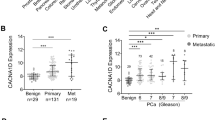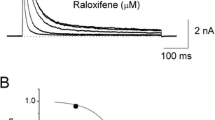Abstract
Large-conductance Ca2+-dependent K+ (BKCa) channels are activated by intracellular Ca2+ and membrane depolarization in an allosteric manner. We investigated the pharmacological and biophysical characteristics of a BKCa-type K+ channel in androgen-dependent LNCaP (lymph node carcinoma of the prostate) cells with novel functional properties, here termed BKL. K+ selectivity, high conductance, activation by Mg2+ or NS1619, and inhibition by paxilline and penitrem A largely resembled the properties of recombinant BKCa channels. However, unlike conventional BKCa channels, BKL channels activated in the absence of free cytosolic Ca2+ at physiological membrane potentials; the half-maximal activation voltage was shifted by about −100 mV compared with BKCa channels. Half-maximal Ca2+-dependent activation was observed at 0.4 μM for BKL (at −20 mV) and at 4.1 μM for BKCa channels (at +50 mV). Heterologous expression of hSlo1 in LNCaP cells increased the BKL conductance. Expression of hSlo-β1 in LNCaP cells shifted voltage-dependent activation to values between that of BKL and BKCa channels and reduced the slope of the P open (open probability)-voltage curve. We propose that LNCaP cells harbor a so far unknown type of BKCa subunit, which is responsible for the BKL phenotype in a dominant manner. BKL-like channels are also expressed in the human breast cancer cell line T47D. In addition, functional expression of BKL in LNCaP cells is regulated by serum-derived factors, however not by androgens.







Similar content being viewed by others
References
Anwer K., Toro L., Oberti C., Stefani E., Sanborn B M. 1992. Ca2+-activated K+ channels in pregnant rat myometrium: modulation by a β-adrenergic agent. Am. J. Physiot. 263:1049–1056
Basrai D., Kraft R., Bollensdorfff C., Liebmann L., Benndorf K., Patt S. 2002. BK channel blockers inhibit potassium-induced proliferation of human astrocytoma cells Neuro Report. 13:403–407
Brenner R., Perez G.J., Bonev A.D., Eckman D.M., Kosek J.C, Wiler S.W., Patterson A.J., Nelson M.T., Aldrich R.W. 2000. Vasoregulation by the β1 subunit of the calcium-activated potassium channel. Nature 407:870–876
Diaz L., Meera P., Amigo J., Stefani E., Alvarez O., Toro L., Latorre R. 1998. Role of the S4 segment in a voltage-dependent calcium-sensitive potassium (hSlo) channel. J. Biol. Chem. 273:32430–32436
Dworetzky S.I., Boissard C.G., Lum-Ragan J.T., McKay M.C., Post-Munson D.J., Trojnacki. J.T., Chang C.-P., Gribkoff V.K. 1996 Phenotypic alteration of a human BK (hSlo) channel by hSloβ subunit coexpression; changes in blocker sensitivity, activation/relaxation and inactivation kinetics, and protein kinase A modulation. J. Neurosci. 16:4543–4550
Erxleben C., Everhart A.L., Romeo C., Florence H., Bauer M.B., Alcorta DA., Rossie S., Shipston M.J., Armstrong D.L. 2002. Interacting effects of N-terminal variation and strex exon splicing on slo potassium channel regulation by calcium, phosphorylation. and oxidation. J. Biol. Chem. 277: 27045–27052
Fernández-Fernández J.M., Tomás M., Vázquez E., Orio P., Lalorre R., Senti M., Marrugsit J., Valverde M.A. 2004. Gain-of-function mutation in the KCNMB1 potassium channel subunit is associated with low prevalence of diastolic hypertension. Clin. Invest. 113:1032–1039
Gribkoff V.K., Starret Jr. J.E., Dworetzky S.I. 1997. The pharmacology and molecular biology of large-conductance calcium-activated (BK) potassium channels. Adv. Pharmacol. 37:319–348
Gutiérrez A.A., Arias J.M., Garcia L., Mas-Oliva J., Guerrero-Hernandéz A. 1999. Activation of a Ca2+-permeable cation channel by two different inducers of apoptosis in a human prostatic cancer cell line. J. Physiol. 517:95–107
Horoszewicz J.S., Leong S.S, Kawinski E., Karr J.P., Rosenthal H., Chu T.M., Mirand E.A., Murphy G.P. 1963. LNCaP model of human prostatic carcinoma. Cancer Res 43:1908–1916
Horrigan F.T., Cur J., Aldnch R.W. 1999. Allosteric voltage gating of potassium channels I: mSlo ionic currents in the absence of Ca2+. J. Gen. Physiol. 114:277–304
Jin P., Weiger T.M., Wu Y., Levitan I.B. 2002. Phosphorylation-dependent functional coupling of hSlo calcium-dependent potassium channel and its hβ4 subunit. J. Biol Chem. 277:10014–10020
Kaczorowski G.J., Knaus H.-G., Leonard R.J., McManus O.B., Garcia M.L. 1996. High-conductance calcium-activated potassium channels: structure, pharmacolcgy, and function. J Bioenerg. Biomembr. 28:255–267
Knaus H.-G., McManus O.B., Lee S.H., Schmalhofer W.A., Garcia-Calvo M., Helms L.M.H., Sanchez M., Giangiacomo K., Reuben J.P., Smith A.B., 3rd, Kaczorowski G.J., Garcia M.L. 1994. Tremorgenic indole alkaloids potently inhibit smooth muscle high-conductance calcium-activated potassium channels. Biochemistry 33:5819–5828
Kraft R., Benndorf K., Patt S. 2000. Large conductance Ca2+ activated K+ channels in human meningioma cells. J. Membrane. Biol. 175:25–33
Lai G.-J., McCobb D.P. 2002. Opposing actions of adrenal androgens and glucocorticoids on alternative splicing of Slo potassium channels in bovine chromaffin cells. Proc. Natl. Acact. Set. USA 99:7722–7727
Lippiat J.D., Standen N.B., Davies. N.W. 2000. A residue in the intracellular vestibule of the pore is critical for gating and permeation in Ca2+-activated K+ (BKCa) channels. J Physiot. 529:131–138
Lippiat J.D., Standen N.B., Harrow I.D., Phillips S.C., Davies N.W. 2003. Properties of BKCa channels formed by bicistronic expression of hSlo α and β1-4 subunits in HEK293 cells. J. Membrane. Biol. 192:141–148
Liu X., Chang Y., Reinhart P.M., Sontheimer H. 2002. Cloning and characterization of glioma BK, a novel BK channel isoform highly expressed in human glioma cells. J. Neurosci. 22:1640–1849
Marrion M.V., Tavalin S.J. 1998. Selective activation of Ca2+-activated K+ channels by co-localized Ca2+ channels in hippocampal neurons. Nature 395:900–905
Meera P., Wallner M., Toro L. 2000. A neuronal β subunit (hKCNMB4) makes the large conductance, voltage- and Ca2+-activated K+ channel resistant to charybdotoxin and iberiotion. Proc. Natl. Acad. Sci. USA. 97:5562–5567
Meera P., Wallner M., Jiang Z., Toro L. 1996. A calcium switch for the functional coupling between (hslo) and β subunits (KV,Caβ) of maxi K channels. FEBS Lett. 382:84–38
Meera P., Wallner M., Song M., Toro L. 1997. Large conductance voltage- and calcium-dependent K+ channel, a distinct member of voltage-dependention channels with seven N-terrninal transmembrane segments (S0-S6), an extracellular N terminus, and an intracellular (S9-S10) C terminus. Proc. Natl Acad. Set. USA 94:14066–14071
Orio P., Rojas P., Ferreira G., Latorre R. 2002. New disguises for an old channel. MaxiK channel β-subunits. News Physiol. Sci. 17:156–161
Ramanathan K., Michael T.H., Jiang G.-J., Hiel H., Fuchs P.A. 1999. A molecular mechanism for electrical tuning of cochleae hair cells. Science 283:215–217
Sansom S.C., Stockand J.D. 1994. Differential Ca2+ sensitivities of BK(Ca) isochannels in bovine mesenteric vascular smooth muscle. Am. J. Physiol. 266:1182–1189
Santarelli L.C., Chen J., Hsinernann S.H., Hoshi T. 2004. The β1 subunit enhances oxidative regulation of large-conductance calcium -activated K+ channels J. Gen. Physiol. 124:357–370
Santarelli, L.C., Wassef, R., Heinemann, S.H., Hoshi, I. 2006. Three methionine residues located within the regulator of conductance for K+ (RCK) domains confer oxidative sensitivity to large-conductance Ca2+- activated K+ channels. J. Physiol. 571:329–359
Schubert R., Nelson M.T. 2001. Protein kinases: tuners of the BKCa channel in smooth musde. Trends Pharmacol. 22:505–512
Shao L.-R., Halvorsrud R., Borg-Graham L., Storm J.F. 1999. The role of BK-type Ca2+-dependent K+ channels in spike broadening during repetitive firing in rat hippocampal pyramidal cells. J. Physiol. 521:135–146
Shen K.-Z., Lagrutta A., Davies N., Standen N., Adeiman J., North R. 1994. Tetraethylammonium block of Slowpoke calcium -activated potassium channels expressed in Xenopus oocytes: evidence for tetrameric channel formation. Pfluegures Arch. 426:440–445
Shi J., Cui J. 2001. Intracellular Mg2+ enhances the function of BK-type Ca2+-activated K+ channels. J. Gen. Physiol. 113:589–605
Skryrna R., van Coppenolle P., Dufy-Barbe L., Dufy B., Prevarskaya N. 1999. Characterization of Ca2+-inhibited potassium channels in the LNCaP human prostate cancer cell line. Receptors Channels 6:241–253
Strøbaeck D., Christopherson P., Holm N.R., Moldt P., Ahring P.K. Johgnsen T.E., Olesen S.-P. 1996. Modulation of the Ca2+-dependenl K+ channel hslo, by the substituted diphenylurea MS 1608, paxilline and internal Ca2+. Neuropharmacology 35:903–914
Thalmann. G.N., Anezinis P.E., Chang S.M., Zhau H.E., Kirn E.E., Hopwood V.L., Pathak S., von Eschenbach A.C., Chung L.W. 1994. Androgen-independent cancer progression and bone metastasis in the LNCaP model of human prostate cancer. Cancer Res. 54:2577–2531
Thurm H., Fakler B., Oliver D. 2005 Ca2+-independent activation of BKCa channels at negative potentials in mammalian inner hair cells J. Physiol 569:137–151
Tseng-Crank J., Foster C.D., Krause J.D., Mertz R., Godinot N., DiChiara T.J., Reinhart P.H. 1994. Cloning, expression, and distribution of functionally distinct Ca2+-activated K+ channel isoforms from: human brain. Neuron 13:1315–1330
Wang Y.-W., Ding J.P., Xia X.-M., Lingie C.J. 2002. Consecquences of the stoichiometry of Slo1 α and auxiliary β subunits on functional properties of large-conductance Ca2+-activated K+ channels. J. Neurosci. 22:1550–1561
Weiger T.M., Hermann A., Levitan I.B. 2002. Modulation of calcium-activated potassium channels. J. Comp. Physiol A. 188:79–87
Weaver A.K., Llu X., Sontheimer H. 2004. Role for calcium-activated potassium channels (BK) in growth control of human malignant glioma J. Neurrosci. Res. 78:224–234
Xia X.-M., Zeng X., Lingle. C.J. 2002. Multiple regulatory sites in large-conductance calcium-activated potassium channels. Nature 418:880–884
Xie J., McCobb D.P. 1998. Control of alternative splicing of potassium channels toy hormones. Science 280:443–446
Zhau H.V., Chang S.M., Chen B.Q., Wang Y., Zhang H., Kao C., Sang Q.A., Pathak S.J., Chung L.W. 1996. Androgen-reprassed phenotype in human prostate cancer. Proc. Natl. Acad. Sci. USA 93:15152–15157
Zhou X.-B., Arntz C., Kamm S., Motejlek K., U., Wang G.-X., Ruth P., Korth M. 2001. A molecular switch for specific simulation of the BKCa channel by cGMP and cAMP kinase. J. Biol. Chem. 276:43239–43245
Acknowledgement
We are grateful for technical assistance by S. Arend and A. Rossner and for helpful discussions with R. Schönherr. This work was supported by the DFG (HE 2993/2), TMWFK (B378-01027) and National Institute of Health.
Author information
Authors and Affiliations
Corresponding author
Rights and permissions
About this article
Cite this article
Gessner, G., Schönherr, K., Soom, M. et al. BK Ca Channels Activating at Resting Potential without Calcium in LNCaP Prostate Cancer Cells. J Membrane Biol 208, 229–240 (2006). https://doi.org/10.1007/s00232-005-0830-z
Received:
Revised:
Published:
Issue Date:
DOI: https://doi.org/10.1007/s00232-005-0830-z




